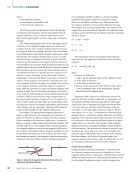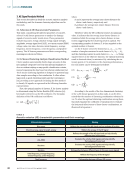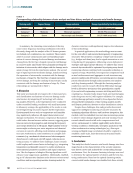ABSTR ACT
In this paper, the relationship between a
discontinuity’s edge angle and magnetic leakage
signal is investigated to provide a new reference
basis for discontinuity reconstruction and to improve
its accuracy. The magnetic leakage signals of
V-shaped, rectangular, and right-angle trapezoidal
discontinuities with different edge angles (i.e., the
angle between the discontinuity boundary and the
horizontal direction) are studied through COMSOL
simulations and experiments. The regression
equations for both are established, and the findings
are summarized. The results show that as the edge
angle increases, the peaks of the axial and radial
signals increase, the peak-to-peak spacing widens,
and the position of the wave peaks gradually shifts
toward the side where the edge angle increases. This
indicates that the edge angle of the discontinuity
directly affects the characteristic behavior of the
discontinuity’s magnetic leakage signal. Therefore,
studying the relationship between these factors
provides a theoretical basis and reference value
for improving the accuracy of discontinuity
reconstruction.
KEYWORDS: magnetic leakage detection, COMSOL simulation,
discontinuity type, edge angle
Introduction
Magnetic flux leakage testing (MFL) is a commonly used
nondestructive testing (NDT) method for identifying surface
and subsurface discontinuities in ferromagnetic materials,
characterized by fast detection speed, high efficiency, and a
wide range of applications (Shaoxuan et al. 2023). In recent
years, the effects of discontinuity size, shape, and angle on
magnetic leakage signals have gradually attracted the interest
of researchers (Mandache et al. 2003 Han et al. 2014a). In a
study on discontinuity leakage detection and magnetic leakage
signals, Alaric et al. (2018) proposed a model to estimate the
orientation of rectangular discontinuities in ferromagnetic
materials. They found that the tangential component best
represents the discontinuity direction, providing support for
reconstructing the discontinuity’s location. Yu et al. (2020)
proposed a discontinuity size estimation method using triaxial
signal features, which not only determines discontinuity ori-
entation but also solves the problem of poor discontinuity
estimation accuracy, enhancing the reconstruction capability
of complex magnetic leakage signals. Ravan et al. (2010) and
Li et al. (2007) simulated discontinuity orientation using finite
element analysis to obtain differences in the results of the
discontinuities with varying angles on the acquired magnetic
leakage signal, and summarized the rule of change. Ganesh
et al. (2020) used an MFL imaging system with 3D modeling
and simulation to detect surface discontinuities on a ferro-
magnetic steam generator tube. They analyzed the effect of
different discontinuity shapes on the MFL signal through finite
element software, and explored factors such as sensor location
to provide a reference on the detection method to ensure the
safety of steam generator tubes.
With the development of artificial intelligence, algorithms
for discontinuity detection have been improved to enhance
accuracy and efficiency. Han et al. (2014a) proposed a multiple
power affine projection method for fast estimation of disconti-
nuity contours. By minimizing the error function to adjust the
weights of the filter, they improved the estimation accuracy
and convergence speed of the algorithm, enabling more
accurate identification of discontinuity features and angular
direction. Han et al. (2014b) proposed a two-dimensional
discontinuity contour estimation method using an effective
particle swarm optimization algorithm, achieving optimal con-
vergence by dynamically adjusting the particles’ speed and
position, with significant adaptability and robustness. Bao et al.
(2021) found that the variation in the magnetic field profile was
STUDY ON THE RELATIONSHIP BETWEEN
FLAW EDGE ANGLE AND MAGNETIC
LEAKAGE SIGNAL CHANGE
ZHIHAO ZHANG†, YONG HONG†*, JIE WANG‡, SHAOJUN WU‡, AND JUNYU RUAN†
ME
|
TECHPAPER
† School of Mechanical Engineering, Shanghai Dianji University, Shanghai
201306, China
‡ Wuhu Special Equipment Inspection Institute, Anhui, 241002, China Wuhu
Industrial Equipment Inspection and Monitoring Engineering Technology
Research Center
*Corresponding author: hongy@sdju.edu.cn
Materials Evaluation 83 (5): 30–40
https://doi.org/10.32548/2025.me-04486
©2025 American Society for Nondestructive Testing
30
M AT E R I A L S E V A L U AT I O N • M AY 2 0 2 5
In this paper, the relationship between a
discontinuity’s edge angle and magnetic leakage
signal is investigated to provide a new reference
basis for discontinuity reconstruction and to improve
its accuracy. The magnetic leakage signals of
V-shaped, rectangular, and right-angle trapezoidal
discontinuities with different edge angles (i.e., the
angle between the discontinuity boundary and the
horizontal direction) are studied through COMSOL
simulations and experiments. The regression
equations for both are established, and the findings
are summarized. The results show that as the edge
angle increases, the peaks of the axial and radial
signals increase, the peak-to-peak spacing widens,
and the position of the wave peaks gradually shifts
toward the side where the edge angle increases. This
indicates that the edge angle of the discontinuity
directly affects the characteristic behavior of the
discontinuity’s magnetic leakage signal. Therefore,
studying the relationship between these factors
provides a theoretical basis and reference value
for improving the accuracy of discontinuity
reconstruction.
KEYWORDS: magnetic leakage detection, COMSOL simulation,
discontinuity type, edge angle
Introduction
Magnetic flux leakage testing (MFL) is a commonly used
nondestructive testing (NDT) method for identifying surface
and subsurface discontinuities in ferromagnetic materials,
characterized by fast detection speed, high efficiency, and a
wide range of applications (Shaoxuan et al. 2023). In recent
years, the effects of discontinuity size, shape, and angle on
magnetic leakage signals have gradually attracted the interest
of researchers (Mandache et al. 2003 Han et al. 2014a). In a
study on discontinuity leakage detection and magnetic leakage
signals, Alaric et al. (2018) proposed a model to estimate the
orientation of rectangular discontinuities in ferromagnetic
materials. They found that the tangential component best
represents the discontinuity direction, providing support for
reconstructing the discontinuity’s location. Yu et al. (2020)
proposed a discontinuity size estimation method using triaxial
signal features, which not only determines discontinuity ori-
entation but also solves the problem of poor discontinuity
estimation accuracy, enhancing the reconstruction capability
of complex magnetic leakage signals. Ravan et al. (2010) and
Li et al. (2007) simulated discontinuity orientation using finite
element analysis to obtain differences in the results of the
discontinuities with varying angles on the acquired magnetic
leakage signal, and summarized the rule of change. Ganesh
et al. (2020) used an MFL imaging system with 3D modeling
and simulation to detect surface discontinuities on a ferro-
magnetic steam generator tube. They analyzed the effect of
different discontinuity shapes on the MFL signal through finite
element software, and explored factors such as sensor location
to provide a reference on the detection method to ensure the
safety of steam generator tubes.
With the development of artificial intelligence, algorithms
for discontinuity detection have been improved to enhance
accuracy and efficiency. Han et al. (2014a) proposed a multiple
power affine projection method for fast estimation of disconti-
nuity contours. By minimizing the error function to adjust the
weights of the filter, they improved the estimation accuracy
and convergence speed of the algorithm, enabling more
accurate identification of discontinuity features and angular
direction. Han et al. (2014b) proposed a two-dimensional
discontinuity contour estimation method using an effective
particle swarm optimization algorithm, achieving optimal con-
vergence by dynamically adjusting the particles’ speed and
position, with significant adaptability and robustness. Bao et al.
(2021) found that the variation in the magnetic field profile was
STUDY ON THE RELATIONSHIP BETWEEN
FLAW EDGE ANGLE AND MAGNETIC
LEAKAGE SIGNAL CHANGE
ZHIHAO ZHANG†, YONG HONG†*, JIE WANG‡, SHAOJUN WU‡, AND JUNYU RUAN†
ME
|
TECHPAPER
† School of Mechanical Engineering, Shanghai Dianji University, Shanghai
201306, China
‡ Wuhu Special Equipment Inspection Institute, Anhui, 241002, China Wuhu
Industrial Equipment Inspection and Monitoring Engineering Technology
Research Center
*Corresponding author: hongy@sdju.edu.cn
Materials Evaluation 83 (5): 30–40
https://doi.org/10.32548/2025.me-04486
©2025 American Society for Nondestructive Testing
30
M AT E R I A L S E V A L U AT I O N • M AY 2 0 2 5













































































